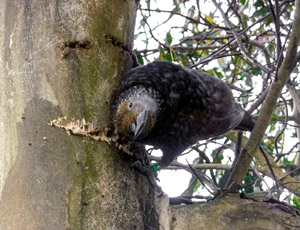Sweet-beaked kākā find tree-sap irresistible
 Tuesday, May 14, 2013 at 23:14
Tuesday, May 14, 2013 at 23:14  Kākā juvenile GG-V demonstrating how to sap feed by gouging through the bark with the convenient can-opener attached to her face, also known as her beak! (Photo by Kerry Charles)Skraaaark. Alfie Kākā here, interviewing Kerry Charles, who has just completed her thesis “Urban human-wildlife conflict: North Island kākā (Nestor meridionalis septentrionalis) in Wellington City”.
Kākā juvenile GG-V demonstrating how to sap feed by gouging through the bark with the convenient can-opener attached to her face, also known as her beak! (Photo by Kerry Charles)Skraaaark. Alfie Kākā here, interviewing Kerry Charles, who has just completed her thesis “Urban human-wildlife conflict: North Island kākā (Nestor meridionalis septentrionalis) in Wellington City”.
Conflict! Sounds like I’ll need my foreign correspondent’s flak jacket for this one. But the set-up looks friendly enough. (Like many dispatches from the front line, this is to be conducted over drinks and nibbles in a neighbourhood watering-hole, though I can hear nearby skrarks and wibbles from a group of young larrikin green-banders just outside). Although it’s full moon, I stick to just one sugar water and a few almonds.
Alfie: Kerry, I’m a bit worried by the idea of a conflict. What’s going on?
Kerry: Well it started when staff at the Botanical Gardens noticed that some of their historic trees had been damaged by bark being stripped off. They noticed damaged trees in other parks then, and also in people’s gardens. Then one day, someone saw a kākā chomping at a tree.
Pretty soon small groups of other kākā were seen doing the same thing. So the Wellington City Council approached Victoria University to see if they could help find out what was happening, and to see what could be done about it. The Council generously provided some funding for a study to investigate.
Alfie: Tell me all about it Kerry. Even though you can’t see them, I’m all ears.
Kerry: OK. First of all we found out that the tree damage was being caused by sap-feeding. Kākā are the only animals in New Zealand that are known to do it. There have been studies done in native forest, but no-one has studied it in an urban environment before. I mapped out a set of areas in public greenspaces to survey, and eventually, I saw kākā sap-feeding first hand. They use two methods – stripping off strips of bark, and also using their beaks to gouge out a line of bark so they can lick the sap that flows just below.
I then focused on identifying which trees were most likely to be targeted. I looked at a variety of factors including the species, size of tree, the nature of the sap, topography of the surrounding area, distance to houses, and distance to Zealandia.
Alfie: And what did you find?
Kerry: In summary, the trees most likely to be damaged are exotics, particularly large conifers high up on exposed ridges and hillsides.
Alfie: And our old familiar native trees were not affected?
Kerry: Not nearly so much. A few natives like mahoe have been, but the main targets were macrocarpa, and lawsoniana. Surprisingly though, good old Pinus radiata wasn’t chosen, despite its abundance in the areas we looked at.
Alfie: (under his beak)…Radiata doesn’t taste great. (cheerily)…What else did you find?
Kerry: Some surprising things Alfie. Earlier work had led to speculation that sap-feeding may be a female’s way of getting a high-energy diet before breeding, but I saw several birds believed to be males doing it too. And I saw tui getting in on the act. Their beaks aren’t strong enough to open up the bark, but once the kākā had done the job the tui were able to lick up some sap themselves – until the kākā chased them away. I also found that kākā were sap-feeding even when there other food sources available close by.
Alfie: Good research skills Kerry! So what’s your advice to the council?
Kerry: Since we now know more about the types of trees that are at risk, it’s easier to locate and keep an eye on potentially hazardous trees. I recommended planting species with greater tolerance to bark damage on public and private land, and retaining trees favoured by kākā for sap-feeding in areas where they pose minimal hazard.
Alfie: So keep some macrocarpa for my pals to feed on?
Kerry: Exactly Alfie. High up on exposed ridges would be ideal. The idea is to provide a food source that may mean that birds will leave trees in other locations alone.
Alfie: Yippee! And what about some sort of repellent to protect the most precious trees?
Kerry: There’s some research going on to find a practical surface repellent for kea, so something similar might work for kākā. It’s a tough one though, as kākā are smart birds and not easily deterred.
Alfie: Indeed we are. Thanks Kerry, this has been fun. Let’s catch up again soon – I want to hear about the survey you did of 1000 residents to find out what they think about us kākā.
Kerry: Sure thing Alfie.
And so I took a last sip of sugar water, hop-climbed up a nearby tree and took off back to the valley. The full moon was bright in the north-eastern sky. A stand of macrocarpa on Johnston Hill stood silhouetted against the skyline. Autumn. Delicious Autumn.
 Nestor meridionalis - Kaka | in
Nestor meridionalis - Kaka | in  Conflict,
Conflict,  Conservation,
Conservation,  Urban parrots
Urban parrots 
